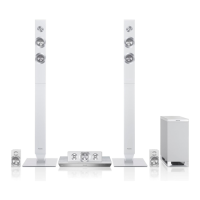
Do you have a question about the Panasonic SC-BTT560 and is the answer not in the manual?
| Disc loading type | Tray |
|---|---|
| Disc types supported | BD, BD-R, BD-R DL, BD-RE, BD-RE DL, BD-ROM, CD, CD-R, CD-RW, DVD, DVD+R, DVD+R DL, DVD+RW, DVD-R, DVD-R DL, DVD-RW |
| Playback disc formats | Blu-Ray video, CD audio |
| Number of optical discs | 1 discs |
| Optical disc player type | Blu-Ray player |
| Built-in HDD | No |
| Multichannel decoding | Yes |
| Image formats supported | JPG, MPO |
| Apple docking compatibility | iPhone, iPod |
| Compatible memory cards | SD, SDHC, SDXC |
| Video formats supported | AVCHD, H.264, MKV, MPEG2, MPEG4 |
| Analog signal format system | NTSC, PAL |
| Audio decoders | Dolby Digital, Dolby Digital Plus, Dolby Pro Logic II, Dolby TrueHD, DTS-HD Master Audio |
| RMS rated power | 1000 W |
| Audio output channels | 5.1 channels |
| Audio formats supported | AAC, FLAC, MP3, WAV, WMA |
| Total Harmonic Distortion (THD) | 10 % |
| Supported radio bands | FM |
| Preset stations quantity | 30 |
| Front speaker type | 2-way |
| Front speaker impedance | 3 Ω |
| Front speakers RMS power | 370 W |
| Center speaker RMS power | 180 W |
| Number of satellite speakers | 2 |
| Satellite speakers RMS power | 250 W |
| Wireless subwoofer | - |
| Subwoofer driver diameter (imperial) | 6.299 \ |
| Product color | Silver |
| Consumer Electronics Control (CEC) | VIERA Link |
| USB version | 2.0 |
| SCART ports quantity | 0 |
| Number of HDMI outputs | 1 |
| AC input voltage | 220-240 V |
| AC input frequency | 50 Hz |
| Power consumption (standby) | 0.1 W |
| Power consumption (typical) | 89 W |
| Main unit weight | 3000 g |
|---|---|
| Subwoofer weight | 4300 g |
| Center speaker weight | 670 g |
| Satellite speaker weight | 480 g |
| Main unit dimensions (WxDxH) | 460 x 279.3 x 40 mm |
| Subwoofer dimensions (WxDxH) | 180 x 300 x 406 mm |
| Front speaker dimensions (WxDxH) | 270 x 270 x 1185 mm |
| Center speaker dimensions (WxDxH) | 280 x 78 x 86 mm |
| Satellite speaker dimensions (WxDxH) | 80 x 75 x 143 mm |
Covers warnings and cautions for unit operation, mains lead, and small objects.
Provides advice on placing the unit, speakers, and subwoofer for optimal performance and safety.
Outlines precautions for using the unit's wireless LAN connection to prevent damage and ensure proper function.
Details on transferring/disposing of the unit and restrictions on unauthorized copied content using Cinavia technology.
Information on safe usage of the AC mains lead, including fuse replacement procedures.
Lists all items included in the product package and their respective part numbers.
Provides a detailed list of part numbers for system components.
Details on the accessories provided with the unit, such as remote control and batteries.
Instructions for cleaning the unit, its lens, and handling discs to prevent damage.
Information on supported disc types, memory cards, and USB devices, along with content formats.
Lists discs and media types that cannot be played by this unit.
Information on region codes for BD-Video and DVD-Video, and other playback restrictions.
An overview of the remote control layout, functions, and how to use them effectively.
Instructions on how to insert batteries and operate the remote control correctly.
Identifies and describes the controls and indicators on the front of the main unit.
Identifies and describes the various terminals and connections on the rear of the main unit.
Guidance on optimal speaker placement for the home theater system.
Instructions for setting up and using the optional wireless speaker system.
Information on enhancing the surround sound experience with additional speakers.
Detailed steps for assembling the front speaker stands.
Instructions on how to connect speaker cables to the main unit and speakers.
Procedure for connecting the speakers to the main unit's terminals.
Guidance on connecting the unit to a TV via HDMI or Optical, and the ARC function.
Instructions for connecting the FM antenna for radio reception.
Instructions for connecting external devices with HDMI terminals.
Instructions for connecting external devices without HDMI terminals using optical audio.
Overview of connecting the unit to a network via wired or wireless connections.
Steps for establishing a wireless LAN connection to a router.
Instructions for connecting the unit to a network using a LAN cable.
Instructions for safely connecting the AC power lead to the unit and a mains socket.
Guide to performing initial setup for language, region, and basic functions.
Steps for configuring network connection settings easily.
Detailed steps for connecting to a wireless network using WPS or manual search.
Instructions for changing the remote control code if multiple Panasonic products are present.
Guidance on checking for and installing firmware updates for improved functionality.
Instructions for inserting discs, SD cards, and using USB devices.
How to select the TV audio input and output it through the unit's speakers.
How to navigate the HOME menu to access various functions and settings.
Instructions for personalizing user icons, wallpapers, and settings.
Methods for switching between different user profiles for personalized experiences.
Details on controlling playback, including stop, pause, search, and frame-by-frame viewing.
Guide to displaying playback info, status messages, and accessing top/pop-up menus.
Instructions for connecting a 3D TV and enjoying 3D video and photo content.
Steps for accessing BD-Live features, requiring network connection and SD card.
Procedures for deleting BD-Video data or formatting the SD card.
Instructions for creating and customizing photo slideshows with background music.
Information on compatible iPod/iPhone models and battery recharging.
Steps for connecting iPod/iPhone via USB port or the dedicated dock.
How to select and play content from an iPod/iPhone.
Explanation of VIERA Link HDAVI Control features for integrated system operation.
How to output TV and STB audio through the unit's speakers.
Steps for connecting audio sources like STBs using HDMI or optical digital audio cables.
Guide to presetting, tuning, and listening to radio stations, including RDS information.
Overview of VIERA Connect services and setup for video communication like Skype.
Instructions for setting up video communication services like Skype.
Using Home Network feature for DLNA server playback of photos, videos, and music.
Instructions for controlling media playback from a DLNA server using a smartphone.
Guide to accessing and using the Option menu for playback and setting adjustments.
Details on adjusting soundtrack, subtitle, angle, and audio channel settings.
Settings for repeat play, random playback, and starting photo slideshows.
Options for setting wallpaper, user icons, and rotating still pictures.
Details on playback information windows and the control panel.
Adjusting picture quality settings like mode, adjustment, clarity, and resolution.
Selecting surround effects like 3D Cinema, Virtual Surround, and Stereo.
Adjusting sound effects, re-mastering, equalizer, subwoofer, and bass settings.
Configuring 3D signal format, picture modes, and manual 3D settings.
Adjusting manual 3D settings like distance, screen type, frame width, and graphic display level.
Settings for HDMI output resolution, 24p output, color mode, and deep color.
Configuring still mode picture types and seamless playback for playlists.
Configuring digital audio output signals, including PCM-Fix and dynamic range compression.
Settings for BD-Video secondary audio, HDMI audio output, and digital audio input.
Configuration of 3D BD-Video playback, AVCHD output, and 3D type settings.
Adjusting language preferences for soundtracks, subtitles, and menus.
Configuring network connection modes, wireless settings, and service parameters.
Managing network drives, remote device operations, and registration types.
Configuring TV aspect ratio, system settings, and ratings levels.
Settings for screen saver, VIERA Link, power off link, and quick start.
Managing unit settings, remote control codes, firmware updates, and system information.
Instructions for adjusting speaker distance delay times and individual speaker levels.
Adjusting surround effects, sound effects, and speaker levels during playback.
Guidelines for attaching speakers to a wall safely and securely.
Procedures for wall mounting speakers and preventing them from tipping or falling.
Safety measures to prevent speakers from tipping or falling when mounted.
Resolving issues with unit not responding to controls or failing to eject discs.
Procedures for returning settings to factory default and troubleshooting remote control issues.
Resolving forgotten ratings passwords and USB connection recognition problems.
Troubleshooting problems related to the unit switching to standby or not turning off.
Addressing issues like no image, distorted picture, video system mismatch, and 3D display problems.
Resolving problems with no sound, low volume, distorted audio, and lack of surround sound.
Troubleshooting disc playback errors, media file issues, and alternative track selection.
Troubleshooting iPod/iPhone operation, radio noise, and network connection problems.
Guidance on understanding messages displayed on the television screen.
Explanation of messages and codes appearing on the unit's display.
Explanation of service numbers, status indicators, and tuning/broadcast information.
Technical specifications including power consumption, dimensions, and operating conditions.
Detailed specifications for speaker drivers and amplifier output power.
Information on supported file formats for MP3, JPEG, MKV, FLAC, WAV, MPO, and 3D still pictures.
Details on video, photo, and audio media types supported for DLNA streaming.
Contact details for customer support within the UK and Ireland.
Information on ordering accessories and consumables directly from Panasonic UK.




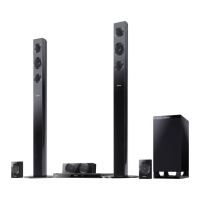
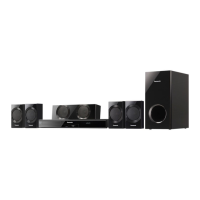
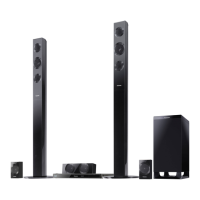
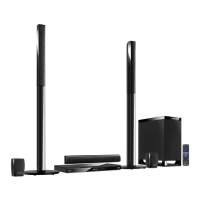
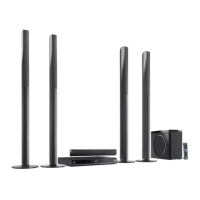
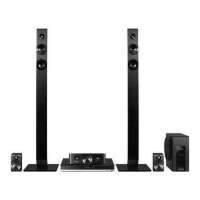
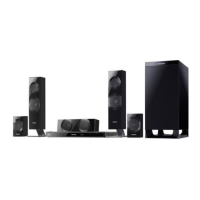
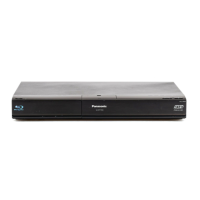
